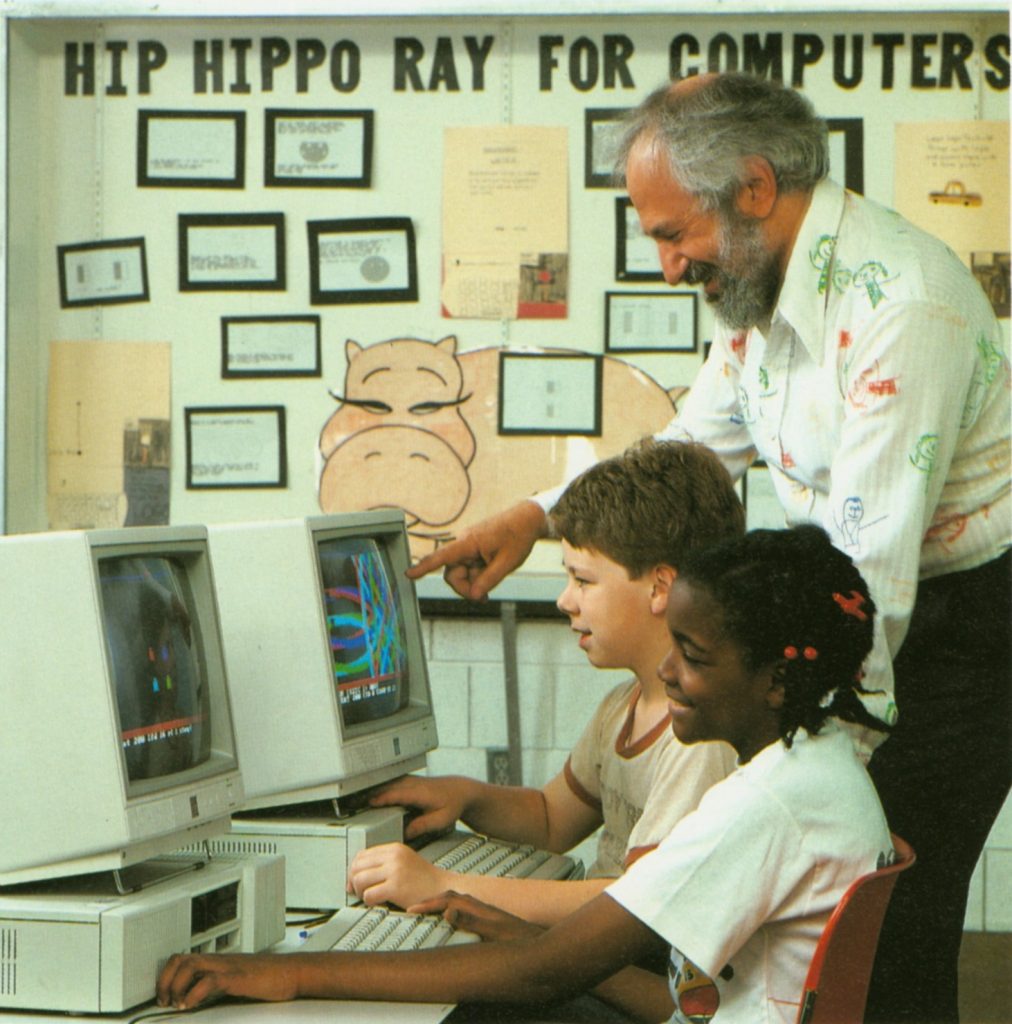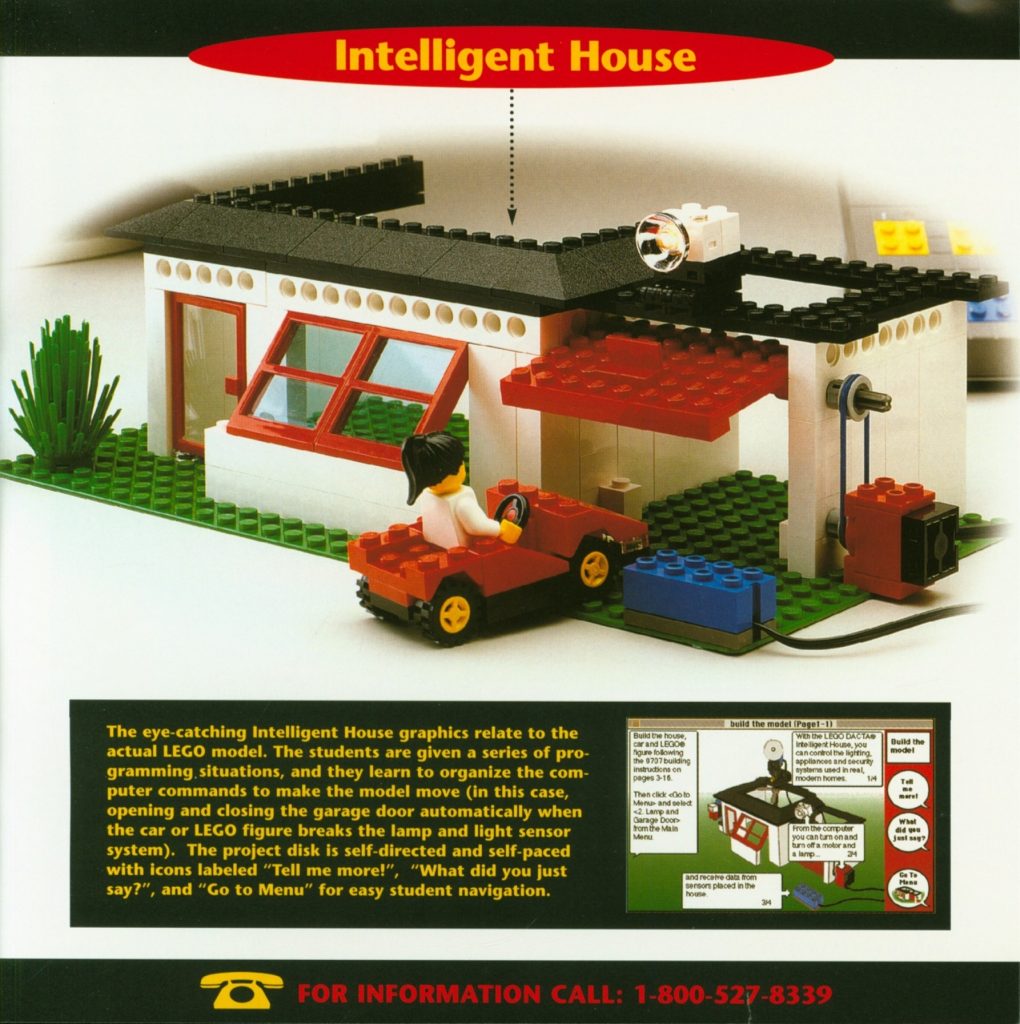LEGO Education is celebrating it’s 40th anniversary! As a birthday gift, we are commemorating the occasion with a three-part history feature on this special division of the LEGO Group. Part 1 provided an overview of the history of LEGO education from the 1980s through 1990s, but we left out an important component of the story. Part 2 picks up where we left off, covering the beginnings of LEGO’s programmable robots in the classroom and at home. These were the precursors of LEGO Mindstorms!

MIT – Magic Is There
When LEGO added Technic to its educational lineup in 1982, it was a game-changer. Through the process of building simple machines out of Technic elements, students would become active participants in learning how they work. It opened the door for new opportunities, including the use of computer coding to program models.

Technic I joined the LEGO education range in 1982
In 1984 LEGO reached out to Seymour Papert, MIT’s professor of mathematics and education and co-founder of their Artificial Intelligence Laboratory. He earned notoriety for developing a solid and easy-to-learn programming language known as Logo. It was Papert’s work with children and computer learning that interested LEGO, as Logo’s application extended to the classroom. In his book Mindstorms (sound familiar?), Papert was a proponent of computers as a teaching tool to help children with systematic problem solving. This attitude was best captured in his statement:
When you learn to program a computer, you almost never get it right the first time. You must isolate and correct ‘bugs.’ The question to ask is: is it fixable? If this concept were generalized…we all might be less intimidated by our fears of ‘being wrong.’

Seymour Papert demonstrating to children the joy of computer learning
Before long, Papert and LEGO agreed to team up, and work began on developing software to make programmable LEGO models. A prototype of the software was ready by 1985, and MIT’s Mitchel Resnick flew out to LEGO headquarters in Billund, Denmark to demonstrate the product. He actually had to haul along his Apple computer because LEGO Futura didn’t have any!
The development of Technic Control
In 1985, LEGO Technic Control debuted at the Didacta Fair in Stuttgart, Germany. Inspired by Papert’s work with Logo, it had been developed with the help of Microelectronics Programme of Britain. The next year, LEGO introduced the Technic Control kit to the UK market. Students were now able to program their own motorized models, either controlling them manually via switches or automatically via computer thanks to a specially designed interface box serving as a bridge between the model and computer. Technic Control distribution expanded throughout Europe.

Technic Control was introduced in 1985
Simultaneously, MIT was carrying out a LEGO-sponsored pilot program in the U.S. at Boston-based public school, the Hennigan School. Unlike Technic Control, the software in the pilot utilized a special version of Logo. Over the course of four weeks, Papert observed the product’s ability to foster excitement in learning, along with its ability to help the performance of slow learners. In recognition of his contributions, Papert was named the first LEGO Professor of Learning Research in 1989.
This work would lead to the release of Technic Computer Control Products, which utilized LEGO TC logo software. A 1992 catalog contained products tailored to different age groups, including Technic Control 0 for elementary and middle school students, Technic Control I for middle and high school and Technic Control II for children to work on more complex models. The interface box was still there, allowing “…students [to] send signals from the computer to LEGO motors and lights, and receive information from LEGO touch sensors and optosensors.”

LEGO TC logo as it was advertised in a 1992 Dacta catalog
Pages from the 1989 TC logo Getting Started manual
Children also began building LEGO robots competitively. In 1992, competitors from MIT met at Boston’s Computer Museum to participate in a robotics competition. Students like sophomore Victor Luchangco programmed their robots ahead of time. This press photo shows Victor setting up his LEGO robot, which was expected to retrieve ping pong balls from the nearby chute and launch them toward a goal.

Students representing MIT competing in 1992 robotics competition
Technic Control Center comes home and goes back to school
In 1990, general LEGO fans were able to bring the programming experience home in the form of Technic set 8094 Control Center. The Control Center was like a light version of the previous education sets, as it did not require a personal computer to operate. Instead, commands were entered via a programmable control panel with two memory banks, capable of storing up to fifty instructions and controlling up to three 9-volt motors simultaneously. Each command could be carried out over a duration of up to 200 seconds. Sales literature advertised the possibility of creating models as complex as machines capable of drawing pre-programmed designs.

Literature for the 1990 LEGO Technic Control Center
The Technic Control Center would also be made available to the education sector via LEGO Dacta and, rather than replacing earlier products, it acted as a no frills supplement to the education lineup. By 1995, teachers could purchase a base unit in the form of set 9753. There was also an activity pack consisting of a teacher’s guide and eighteen activity cards for students to tackle.

Technic Control Center was adopted by LEGO Education
One of the drawbacks to the Control Center was that it required 6 “C” batteries to operate. This issue was rectified by the release of set 8485 Technic Control Center II in 1995, which utilized an AC adapter for conveying power from electrical outlet to device. The base model for the education sector was introduced a year later, whereas set 8485 had been developed for the general consumer market. One of the most iconic models you could build right out of the box was a hulking T-rex. LEGO’s pride in this particular build extended to a massively upscaled version at LEGOLAND theme parks.
TV commercial for Technic Control Center II
Dacta Control Lab
While the Control Center offered an outlet for programming without a PC, LEGO continued to support PC-compatible Technic Control products as their “bread-and-butter.” To keep up with the fast pace of technology, this line received an upgrade in 1993 with the LEGO Dacta Control System. The new software used a special version of the Logo programming language called Control Lab. LEGO also included a new serial interface box with eight output and eight input ports.

An overview of Dacta Control Lab from the 1995/1996 LEGO Education catalog
Dacta Control Lab software interface
A 1995/1996 catalog shows students making a wide range of models, including a robotic sorting system and representation of a greenhouse. The most prominently advertised model was the Dactasaur, a brick-built dinosaur which could be used to measure distance and time to determine its average speed. This was done through the use of angle and light sensors.

Building the Dactasaur

1995-1996 catalog image illustrating use of Dacta Control Center for collaborative learning.
In 1996, the Dacta Control Lab received an interesting supplement in the form of the Intelligent House set. Intelligent House was a unique product, in that it aimed to simulate the use of automated systems in modern homes. It consisted of of over 153 pieces, a 9-volt micromotor, light brick and light sensor. Software featured an easy-to-use interface with thirteen different activities, in which students could use programming language to operate features built into their little LEGO homes. Functions included outdoor lighting, a garage door burglar alarm, door lock, ceiling fan and satellite dish.

Brochure for LEGO Dacta Intelligent House
A brochure for the Intelligent House featured a list of benefits that included gender equity. “The Intelligent House theme is a popular one with many real-life applications to which all students can relate.” With the exception of one male student, the brochure’s illustrations prominently featured girls actively engaged with the product. Even the minifigure shown with the set was wearing female hair.

Inside the LEGO Intelligent House brochure
In 1997, LEGO took their Dacta Control Lab to Planetfest in Pasadena, CA. The event operated in conjunction with the landing of the Mars Pathfinder spacecraft, and attendees were given a look at the first live images taken from the red planet. As a tie-in, LEGO brought computer-controlled Dacta “rovers” for kids to maneuver over a simulated martian landscape. They also held workshops for children and teachers, in which participants were challenged to build problem-solving robots.

Dacta rovers were used to tie-in with the 1997 Mars rover landing
Look out for Part 3
The story is drawing to a close! Stick around with us for our 3rd and final istallment in this series, in which we explore the development behind and launch of LEGO Mindstorms. To tide yourselves over until then, be sure to read Part 1 where we discuss LEGO Education’s early history through the 1990s.







Good article! Much more about this is on my website, http://www.mindsbeforethestorm.com.
This was a fantastic article. As a fan of LEGO my entire life, especially Technic and Midterms, I really loved the details.
Also as a fan that owns most of the programmable bricks and interfaces (at least NXT and before), the details provided here was an excellent walk down memory lane, as I remember the news articles and the things that inspired me to build my own interfaces back in the ’80’s with my Commodore 64.
On a parenthetical note, I was more than pleasantly surprised to find this third party 4.5 v programmable interface called SEQ.
https://youtu.be/71g4hc_Qvms
https://youtu.be/KNNjYBnxPe0
As far as I can tell, they were made circa 1985, but I don’t have much info beyond that
I was very honoured to write an article for the latest issue of Hispabrick (volume 32) where I detailed a few more things about the SEQ but, as yet, I haven’t found anyone who knows anything about them.
The actual interface is like the Control Lab 2- it retains the program in static memory until you turn it off.
Anyway, thought I’d glom onto this post because a) the article was fantastic and b) the SEQ is parenthetically related :)
David, I want to talk to you about this SEQ product. I watched your videos. I’ll email you through your Lugnet email address.